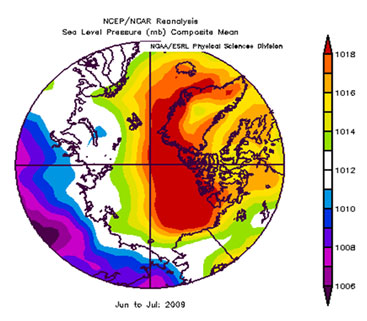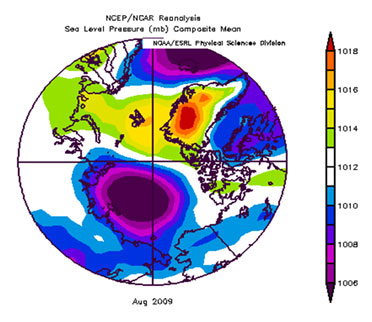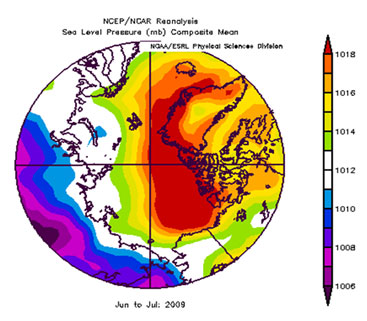As suggested by the 15-day forecast from early August (discussed in the August Outlook report), the weather pattern for August completely changed from the pattern of June and July, decreasing the chance of a record September sea ice loss for 2009. The September minimum is likely to be around 5.0 million square kilometers, compared to around 4.5 million square kilometers for 2008 and 4.1 million square kilometers for 2007. It should be noted that this 2009 extent would still be well below the average for 1979–2000 of 6.7 million square kilometers. See the NSIDC Arctic Sea Ice News & Analysis website for daily updates.
Figure 1 (below) is the sea level pressure field for June and July 2009, showing the Dipole/negative Arctic Oscillation pattern with high pressure on the North American side of the Arctic. This pattern is favorable for sea ice loss as the winds, which roughly follow the contour lines, blow from the Bering Strait region across the entire Central Arctic. In contrast, Figure 2 (August) shows a localized low pressure region over the Central Arctic with higher pressure on the Atlantic side of the Arctic. This August pattern appears unfavorable to sea ice loss. These wind patterns would tend to keep polar air over the Arctic. Observations from the North Pole Environmental Observatory indicate that freeze-up started in late August (almost a week earlier than in other recent years), surface ocean temperatures are at the freezing point, and a near lack of snow cover will promote rapid ice growth.


Two interesting notes from the news. 2009 is the fourth time in five years that the Northeast Passage has been opened. Polar bears had more sea ice cover and better hunting this year in Hudson’s Bay than in other recent years.


